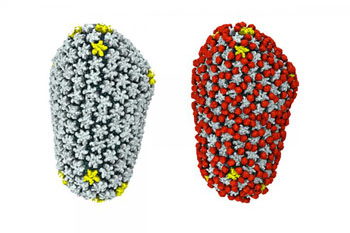HIV Binding Simulations Reveal How the Virus Invades the Host Cell Nucleus
By LabMedica International staff writers
Posted on 14 Mar 2016
A team of molecular virologists has combined advanced cryoelectron microscopy (cryo-EM) with the processing power of two supercomputers to develop a model that explains how HIV interacts with the host cell factor cyclophilin A (peptidylprolyl isomerase A) to invade the nucleus of human cells.Posted on 14 Mar 2016
Cyclophilin A is known to interact with several HIV proteins, including p55 gag, Vpr, and capsid protein, and has been shown to be necessary for the formation of infectious HIV virions. As a result, cyclophilin A contributes to viral diseases such as AIDS, hepatitis C, measles, and influenza A.

Image: The naked HIV capsid, left, would be quickly detected and eliminated from the cell, but a host protein, cyclophilin A, in red in the image on the right, binds to the capsid and enables it to transit through the cell undetected (Photo courtesy of Dr. Juan Perilla, University of Illinois).
Researchers have historically relied on NMR and X-ray diffraction techniques to determine the structures of molecular complexes and proteins that play a role in the causes of various disease states. Structural information about a variety of medically important proteins and drugs has been obtained by these methods. Cryo-EM is a complementary analytical technique that provides near-atomic resolution without requirements for crystallization or limits on molecular size and complexity imposed by the other techniques. Cryo-EM allows the observation of specimens that have not been stained or fixed in any way, showing them in their native environment while integrating multiple images to form a three-dimensional model of the sample.
Investigators at the University of Illinois (Urbana-Champaign, USA) used cryo-EM to establish the structure of cyclophilin A in complex with the assembled HIV-1 capsid at a resolution of eight angstroms. The structure exhibited a distinct cyclophilin A-binding pattern in which the cyclophilin A protein selectively bridged the two capsid protein hexamers along the direction of highest curvature.
The investigators then exploited the combined processing power of two supercomputers to simulate interactions between cyclophilin A and the HIV capsid. Building this model required simulating the interactions of some 64 million atoms.
Results, which were confirmed by solid-state NMR analysis, revealed that the cyclophilin A binding pattern was achieved by single cyclophilin A molecules simultaneously interacting with two virion capsid subunits, in different hexamers, through a previously uncharacterized non-canonical interface.
"We have known for some time that cyclophilin A plays a role in HIV infection," said senior author Dr. Klaus Schulten, professor of physics at the University of Illinois. "We knew every atom of the underlying capsid, and then we put the cyclophilin on top of that, of which we also knew every atom. The HIV capsid has to show some of its surface to the nuclear pore complex so that it docks there properly and can inject its genetic material into the nucleus. Now, we understand a little bit better the HIV virus' strategy for evading cellular defenses. That gives insight into battling the system."
The study was published in the March 4, 2016, online edition of the journal Nature Communications.
Related Links:
University of Illinois













